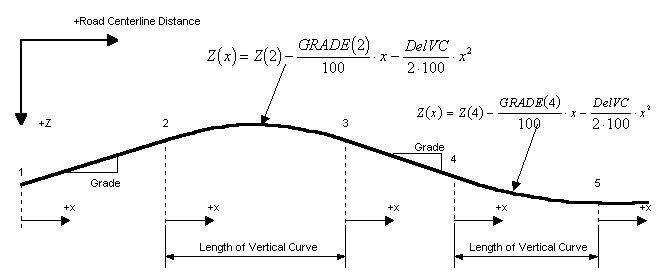STISIM Drive (SDL) - VC - Vertical Curvature
The Vertical Curve event "VC" is used to define the elevation of the roadway centerline as a function of roadway distance. Two types of vertical curvatures can be specified: a constant grade, and a vertical curve. The vertical curvature figure shows the geometry of both the constant grade (segments 1-2 and 3-4), and the vertical curve (segments 2-3 and 4-5). Grade is in percent grade (ft/ft), and a negative grade means a "down hill" road. A vertical curve is a section of road where the grade changes at some constant rate as a function of distance traveled. The vertical curve is specified using two parameters: the length of the vertical curve, and the rate of change of grade in percent grade per foot (DelVC in the figure). At the end of a vertical curve, the roadway will continue at that grade until the next vertical curve event is reached. Because of problems generating intersections, you may want to level off the roadway after your vertical curvature so that the intersections will be displayed properly. In addition, this event does require you to pay close attention to what you are requesting, and requires a small amount of math to understand what is happening as you compute the elevations that you will end up with.
EVENT PARAMETERS:
|
PARAMETER 1: |
The longitudinal length of the vertical curvature, measured in feet. |
|
PARAMETER 2: |
Rate of change of the grade with distance along the vertical curve, measured in (percent grade/feet) (100 * feet/feet)/feet. This parameter causes the grade to change linearly along the roadway. |
EXAMPLE:
1000,VC,500,.01
2000,VC,1000,-.01
The first line will start a
vertical curve at the roadway distance of 1000 feet. The vertical curve will be
500 feet long, and end at 1500 feet. Since all roadways start with a zero grade
and zero elevation, the grade will be zero at the beginning of the vertical
curve. The grade will change 0.01x500=5% over the distance of the vertical
curve, so at the end of the vertical curve, the roadway will be a 5% grade
uphill. The elevation at the end of the vertical curve will be -0.01/2/100*5002
= -12.5 feet. Between the end of the first vertical curve (1500 feet),
and the beginning of the second vertical curve (2000 feet), the roadway will
have a constant grade of 5%, so the elevation will change –5/100*500 = -25
feet, so the elevation at 2000 feet will be –37.5 feet. The second vertical
curve will change the grade –0.005*1000 = -5% over 1000 feet, so the grade at
the end of the second vertical curve will be zero (flat road). The elevation
change during the second vertical curve will be –5/100*1000 + 0.005/2/100*10002
= -25 feet, so the elevation at the end of the second vertical curve will be
–62.5 feet.
